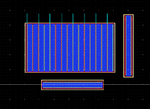AMSA84
Advanced Member level 2

- Joined
- Aug 24, 2010
- Messages
- 577
- Helped
- 8
- Reputation
- 16
- Reaction score
- 8
- Trophy points
- 1,298
- Location
- Iberian Peninsula
- Activity points
- 6,178
Hi guys, I would like to ask you for you opinion.
I am designing a simple current mirror, and I'd like to know which way is best to interleave the transistors:
1 - 25/1.5um
2 - 250/1.5um
In the left side you can see a configuration of 22 transistors - 20 for the 250/1.5um (which gives 12,5um per finger) and 2 x 12,5um (for the 25um transistor).
The idea was to get this config:
AAAAAAAAAA BB AAAAAAAAAA
The starting diffusion is the source so that in the transition A to B they share the source.
On the right configuration, you can see:
12 transistors - 10 for the 250/1.5um (which gives 25 per finger) and the 1 + 1 of 25um each one. In this configuration I have to add a "dummy" transistor in order to get the perfect match between the diffusion.
Which one should I go for?
In one case I have long channel length on the other not, which might translate in more parasitic capacitance and resistance when compared to the other option?
Regards.
I am designing a simple current mirror, and I'd like to know which way is best to interleave the transistors:
1 - 25/1.5um
2 - 250/1.5um
In the left side you can see a configuration of 22 transistors - 20 for the 250/1.5um (which gives 12,5um per finger) and 2 x 12,5um (for the 25um transistor).
The idea was to get this config:
AAAAAAAAAA BB AAAAAAAAAA
The starting diffusion is the source so that in the transition A to B they share the source.
On the right configuration, you can see:
12 transistors - 10 for the 250/1.5um (which gives 25 per finger) and the 1 + 1 of 25um each one. In this configuration I have to add a "dummy" transistor in order to get the perfect match between the diffusion.
Which one should I go for?
In one case I have long channel length on the other not, which might translate in more parasitic capacitance and resistance when compared to the other option?
Regards.




